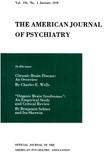TWO DIFFERENT TYPES OF POST-TRAUMATIC NEUROSES
Abstract
1. The incidence of post-traumatic neuroses varies considerably since the development of psychogenic disturbance depends upon emotional factors related to the accident. Terrifying events, such as the Cocoanut Grove fire disaster, have a higher incidence of neuroses traceable to the circumstance of the accident than the everyday head injuries in civilians.
2. A differentiation can be made between "fear neurosis" and "conflict neurosis" as such conditions are designated by Symonds. The former are characterized by emotional disturbance and nightmares immediately following the accident, which recapitulate the circumstances of the injury. This type of neurosis developed in 54 percent of the victims of the Cocoanut Grove disaster, who had gone through a harrowing experience. The latter type occurred in about one-third of our series of head injury patients. Here, as a rule, the neurosis developed after an interval, at a time when the patients were physically fit to return to their duties. Nightmares were characteristic for these patients but they, too, occurred after an interval, usually during the first or second week after the patients had returned home and were faced with return to their former activities, which were charged with conflicts These conflicts were mainly related to financial, occupational or domestic difficulties.
3. No post-traumatic hysteria occurred in any of the Cocoanut Grove disaster patients or in any of the 200 cases with head injuries, all of whom had been hospitalized immediately following injury. It seems that, at present, hysteria hardly ever develops under the eyes of the physician but that we are usually faced with the fully developed condition.
Access content
To read the fulltext, please use one of the options below to sign in or purchase access.- Personal login
- Institutional Login
- Sign in via OpenAthens
- Register for access
-
Please login/register if you wish to pair your device and check access availability.
Not a subscriber?
PsychiatryOnline subscription options offer access to the DSM-5 library, books, journals, CME, and patient resources. This all-in-one virtual library provides psychiatrists and mental health professionals with key resources for diagnosis, treatment, research, and professional development.
Need more help? PsychiatryOnline Customer Service may be reached by emailing [email protected] or by calling 800-368-5777 (in the U.S.) or 703-907-7322 (outside the U.S.).



